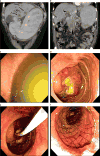A Multidisciplinary Approach to Pancreas Cancer in 2016: A Review
- PMID: 28139655
- PMCID: PMC5659272
- DOI: 10.1038/ajg.2016.610
A Multidisciplinary Approach to Pancreas Cancer in 2016: A Review
Abstract
In this article, we review our multidisciplinary approach for patients with pancreatic cancer. Specifically, we review the epidemiology, diagnosis and staging, biliary drainage techniques, selection of patients for surgery, chemotherapy, radiation therapy, and discuss other palliative interventions. The areas of active research investigation and where our knowledge is limited are emphasized.
Conflict of interest statement
Figures








References
-
- Siegel RL, Miller KD, Jemal A. Cancer statistics, 2016. CA Cancer J Clin. 2016;66:7–30. - PubMed
-
- Howlader N, Noone AM, Krapcho M, et al., editors. SEER Cancer Statistics Review, 1975–2013. National Cancer Institute; Bethesda, MD: available at http://seer.cancer.gov/csr/1975_2013/, based on November 2015. SEER data submission, posted to the SEER website, April 2016.
-
- Raimondi S, Lowenfels AB, Morselli-Labate AM, et al. Pancreatic cancer in chronic pancreatitis: aetiology, incidence, and early detection. Best Pract Res Clin Gastro. 2010;24:349–58. - PubMed
-
- Lowenfels AB, Maisonneuve P, Cavallini G, et al. Pancreatitis and the risk of pancreatic cancer. N Engl J Med. 1993;328:1433–7. - PubMed
-
- Ben Q, Xu M, Ning X, et al. Diabetes mellitus and risk of pancreatic cancer: a meta-analysis of cohort studies. Eur J Cancer. 2011;47:1928–37. - PubMed
Publication types
MeSH terms
Substances
Grants and funding
LinkOut - more resources
Full Text Sources
Other Literature Sources
Medical

